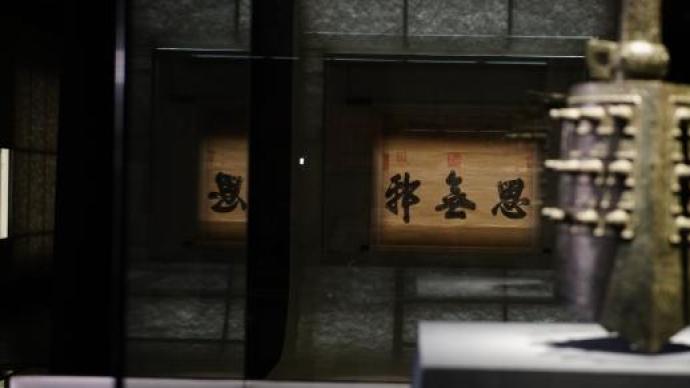
The study is the place where people rest their spirits. From Liu Yuxi's shabby house to Lu You's book nest, from Ni Yunlin's Yunlin Hall to Zhang Dai's Plum Blossom Book House and Bu'er Zhai, the study has strong humanistic feelings. The study room can be a shabby room with "moss marks on the steps green, grass color into the curtain green", or a spacious residence with all kinds of precious antiques displayed on several desks and Duobaoge. , to contemplate the old-fashioned love".
With the study as the core, from August 30th, the exhibition "Seeing the Heart of Heaven and Earth - The Intention and Elephant of the Chinese Study" will be displayed in the Meridian Gate Exhibition Hall of the Palace Museum. Peng Mei News saw at the exhibition site today that through the works of Guo Xi, Mi Fu, Yang Weizhen, Ni Zan and others, the audience can imagine their study; The feelings of the country; "Hongli is the first and the second picture axis" and the painted Chinese play objects are displayed together, restoring the emperor's study. 
exhibition site
It is reported that this exhibition is divided into three units, the first unit is "Wei Huai Qin Shu", which is divided into four spaces: the entrance to the wall star, the five classics extraction room, the four treasures of the study, and the literati appreciation. The four treasures of the study on display highlight the ecological dependence formed between it and the literati; the appreciation part displays jade cong, bronze ware, famous Song porcelain kilns, etc.; the second unit mainly displays calligraphy and painting works, and the exhibiting cultural relics include Guo Xi and He Quan The picture page of "Caotang Guest Talk", Wen Tianxiang's "Xingshu Shanghongzhaitie" volume, Xu Wei's "Xingshu Houjintang Ji" scroll in Ming Dynasty, Chen Chun's "Xingshu Yueyang Tower" volume and other calligraphy works; the third unit is titled "Jieqishuang" Snow", divided into two spaces, Sanyou Tongde and Yaji singing. On display are cultural relics with the theme of pine, bamboo and plum, as well as paintings and calligraphy on the theme of the Orchid Pavilion, such as the volume of "Orchid Pavilion Preface and Postscript in Running Script" by Mi Fu of the Song Dynasty, the album of "Xiao Ao Dongxuan Poems in Running Script" by Yang Weizhen of Yuan Dynasty, "Xiyuan Elegant Collection" volume, Shen Shi's "Lanting Xiuxi Map" volume, etc. 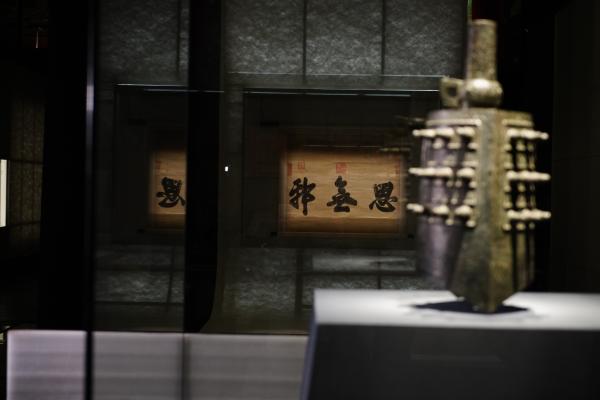
exhibition site
"Mingyue's Temptation Returns Alone": Looking at the literati's sentiments in the precious paintings and calligraphy of Song Yuanming
In the Northern Song Dynasty, Guo Xi's "Picture of Pingyuan with Rocks" shows the painter's in-depth observation of nature and the experience of the soul. The mountains are lined up like a barrier, and the sky is clear and dust-free. The miscellaneous trees growing in the exposed rock crevices, although not as tall and straight as the pines, still pierce the sky; although the leaves have fallen, but the old branches are still vigorous; although it is late autumn, the sky and the earth are open, and I forget both things. 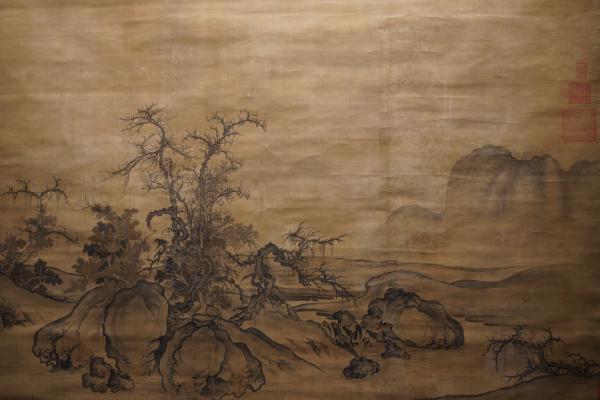
Northern Song Dynasty Guo Xi's "Picture of Pingyuan" (detail)
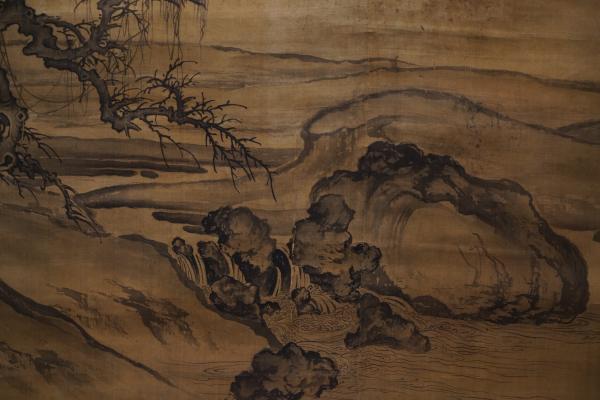
Northern Song Dynasty Guo Xi's "Picture of Pingyuan" (detail)
A first-class cultural relic, the picture page of He Quan's "Thatched Cottage Guest Talk" in the Song Dynasty combines the thatched cottage with the pavilion, which reminds people of "Zhuge Cottage in Nanyang, Yunting Pavilion in Xishu". In the thatched cottage with an I-shaped gallery, the host and the guest are sitting in front of the screen and talking. The stream crossed the front door, and the boy was leading the guests into the hospital. Following the stone steps is a Ziyun Pavilion, one person is lying on the couch, and there are different books on the table behind it. The study can also be a pavilion, surrounded by mountains and rivers, reading, viewing the scenery, taking a nap, and integrating with nature. 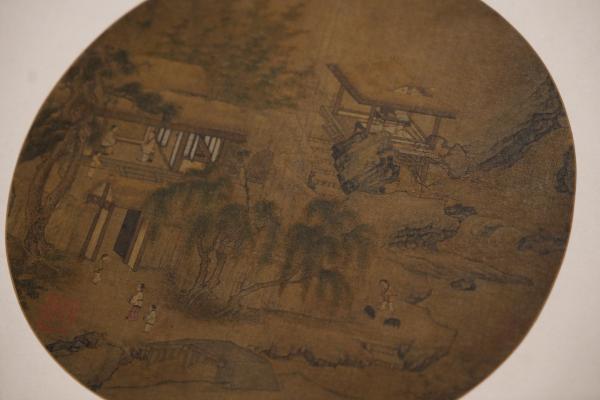
Song Hequan's "Caotang Guest Talk"
The first-class cultural relic, Ni Zan's running regular script Danshi poem scroll, is a poem and book written by Ni Zan for his friend Zongdao. A lonely and indifferent mood. 
Ni Zan's Scroll of Danshi Poems in Regular Script
Mi Youren's "The Wonders of Xiaoxiang" in the Northern Song Dynasty shows the changing scenery of smoke and clouds in the south of the Yangtze River. This theme was called "Mi's Cloud Mountain" by later generations, and was created by Mi Fu and Mi Youren and their sons. Mi Fu's paintings on this subject do not exist. This picture is Mi Youren's representative work. It is a new style of landscape painting in the Song Dynasty. It has a bold and innovative spirit and has far-reaching influence on future generations. 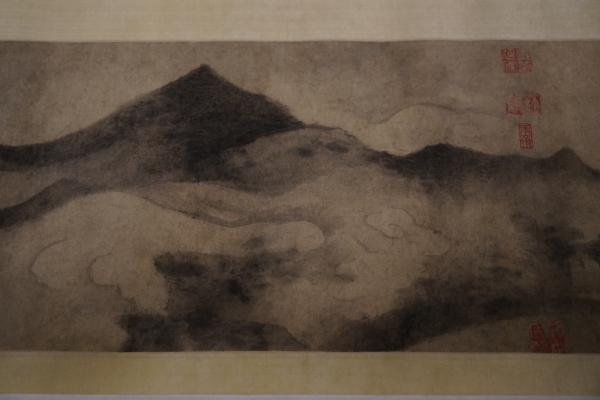
Mi Youren, Northern Song Dynasty, "The Wonders of Xiaoxiang" (Partial)
A first-class B-class cultural relic, Tang Yin's "Shuangjian Xingwo Map and Booklet" in the Ming Dynasty was made by Tang Yin for his friend Wang Rong's "Shuangjian Xingwo" bookstore. In the book, gold, water, and heart are used as mirrors to illustrate the importance of cultivating the nature of the mind in order to understand the way. 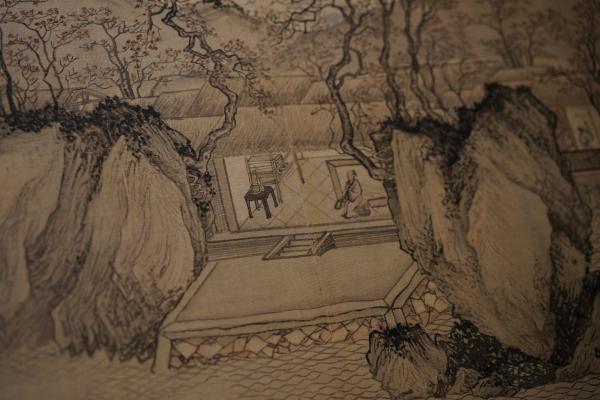
Ming Tangyin "Shuangjian Xingwotu and Booklet" (part)
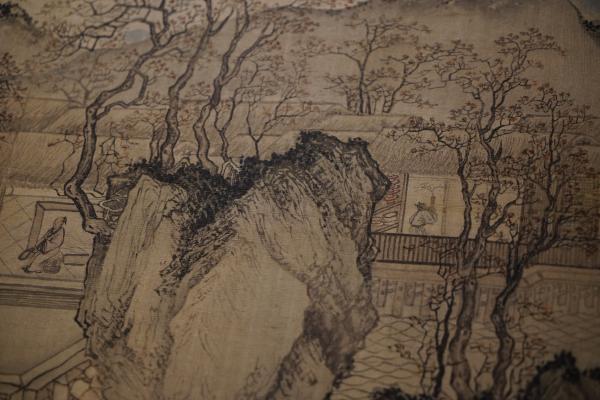
Ming Tangyin "Shuangjian Xingwotu and Booklet" (part)
In Ming Dynasty, Wen Zhengming's "Inscription Scroll of the Shabby Room" in running script, copied Liu Yuxi's "Inscription of the Shabby Room". "Inscription of the Shabby Room" is a famous article about the study by the Tang Dynasty. The virtue of a humble house comes from Yan Yuan's deeds of living in a humble alley and eating and drinking. The simplicity of his residence reflects the nobleman's ambition and feelings of being noble, self-sustaining, and poverty-stricken. This scroll was made when Wen Zhengming was eighty-four years old. The brushwork is elegant and vigorous, and it is a calligraphy in his very old age. 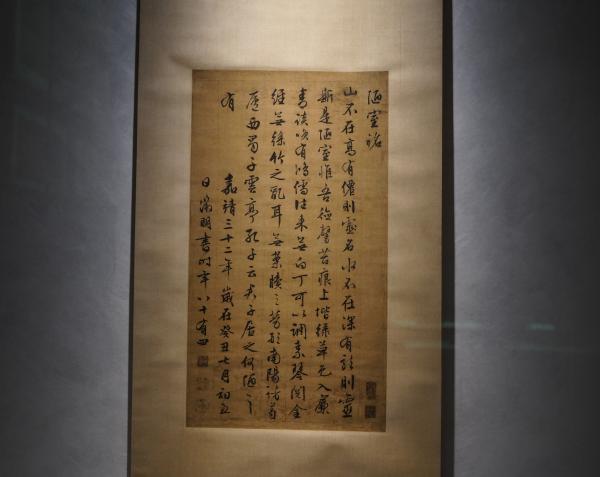
Ming Wen Zhengming "The Inscription Scroll of the Shabby Room in Running Script"
Yuanji (Shi Tao)'s "Searching for Qifeng Scrolls" in the Qing Dynasty is very distinctive. It depicts heavy peaks and dense trees, river bridges and city walls, vague houses, and winding paths. It is a magnificent scene of northern mountains and rivers. The composition of this work is open vertically and horizontally, and the momentum is deep and powerful. The painter's title "Searching all the peaks to make a draft", together with the long postscript written after the picture, expresses the creative idea of imitating nature. 
Qing Shitao, "Searching for all the pictures of Qifeng" (detail)
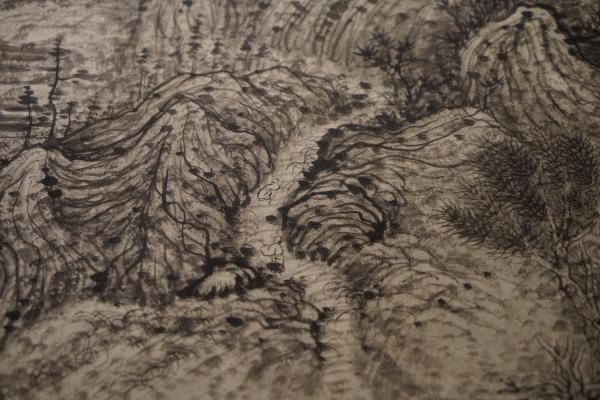
Qing Shitao, "Searching for all the pictures of Qifeng" (detail)
Living in a humble house and worrying about the world: Looking at the family and country feelings of the ancients from the perspective of "The Story of Yueyang Tower in Running Script"
Exhausted his loyalty, to his talents, to be kind to the people. To live tirelessly, to act faithfully, and to take care of the world to achieve goodness is also the ideal and goal of people with lofty ideals and benevolent people from generation to generation. 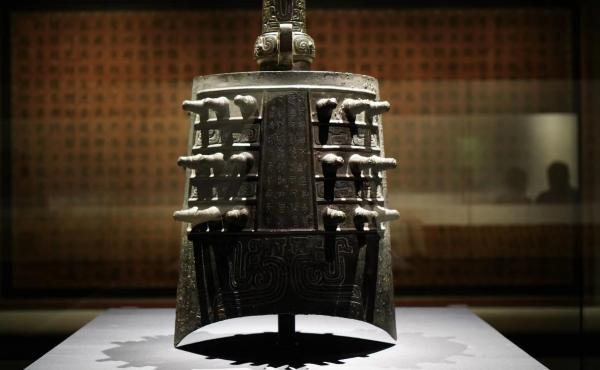
In the late Western Zhou Dynasty, Guo Shulu once cast one of the bells for his father
In order to strengthen the construction of the ritual system, Zhou people made inscriptions to praise ancestors and engrave their achievements. In the late Western Zhou Dynasty, Uncle Guo once cast a set of chimes for his father. This is the largest one, with an inscription of 91 characters. While recalling the merits of ancestors, sacrificing one's own honor, and appreciating the gifts of the royal family, the inscription highlights the inheritance of the clan system and expresses the beautiful vision of praying for the blessings of the fathers and the descendants. 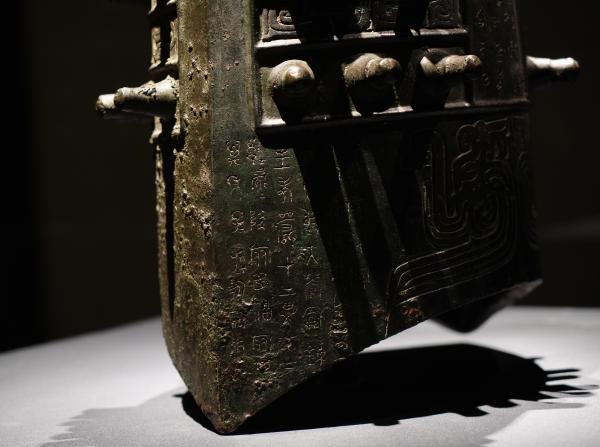
In the late Western Zhou Dynasty, Guo Shulu once cast a bell inscription for his father.
In Ming Dynasty, Chen Chun's "Records of Yueyang Tower in Running Script" copied Fan Zhongyan's famous article "Records of Yueyang Tower" in the Northern Song Dynasty. The text reflects the Confucian scholar-bureaucrat's spiritual realm of "not happy with things, not sad with himself" and the feeling of taking the world as his responsibility. The whole volume is written in line, with dripping ink and magnificent momentum. 
Ming Chen Chun's "Rolling Scroll of Yueyang Tower"
Xu Wei in the Ming Dynasty, "The Scroll of the Day Jintang in Running Script". "Day Jintang Ji" was written by Ouyang Xiu for Han Qi, Duke of Wei. Han Qi, courtesy name Zhigui, was born in Xiangzhou (now Anyang, Henan), and was a statesman in the Northern Song Dynasty. "Rijintang Ji" praised Han Qi's achievements in "virtuous life" and "contribution to the society", reflecting the political ideals of the Northern Song Dynasty Confucianism. 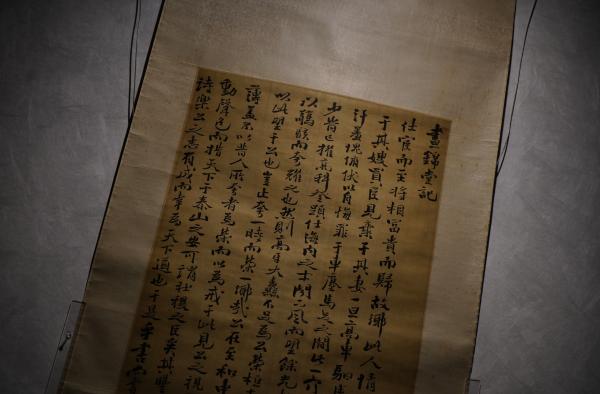
Ming Xu Wei's "Running Script Day Jintang Scroll"
The Hongli Book "Dabaozhen Hanging Screen" is displayed in the Hongde Hall to show self-alert. "Dabaozhen" was written by Zhang Yungu in the Tang Dynasty. The text explained the Confucian thought of the monarch, and it was an exhortation and warning to the monarch. As a scholar, it is his duty to discipline the ruler, and he believes that the emperor should be strict with self-discipline and make every effort to govern. Love the people and be selfless. It is one person who rules the world, not the whole world serving one person. The emperor's every move should not be arbitrary and capricious. The ritual system should be used to prohibit the emperor's extravagance, and the elegant music should be used to prevent the emperor's debauchery. The left historian should record the words of the emperor, and the right historian should record the behavior of the emperor. 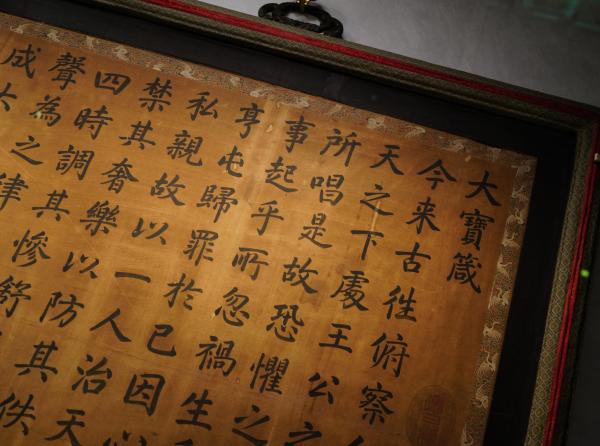
Part of "Dabaozhen Hanging Screen" in Hongli Book
"Five Classics Extraction Room", "Hongli is one and two picture axes": the art space of the emperor
According to the Palace Museum, this exhibition has been in preparation for nearly two years, and there are ingenious ideas everywhere. In addition to the exhibition of cultural relics, the study exhibition also focuses on restoring the original state of the study, reproducing the study space and artistic atmosphere.
The oldest astrological chart is displayed on one wall of the exhibition hall of Xiyanchilou. Two beams of lights illuminate the seventh star, which is composed of two stars among the seven stars in the north. Because it is located to the east of Murosu, it is very similar to the wall of Murosu. In the Tang Dynasty, Zhang Shuo's poem "The Book House in the East Wall and the Hanmo Forest in the West Garden" was written in the poem "Feasting on the Lizheng Hall Academy and Fu Delin". The "Book" preface records: "To the King of Lu, he wanted to rule the palace, destroyed the old house of Confucius, and expanded his residence. In the wall, he obtained the ancient texts of Yu, Xia, Shang and Zhou, as well as the "Biography", "The Analects of Confucius" and "The Analects of Confucius". The Classic of Filial Piety, all of which are subject to fighting." Later generations used "Lu Bi" to refer to ancient cultural classics.
Under the illumination and guidance of the wall house, the wall star in the sky is connected with the lubi on the ground, which also expands our thinking on the context of the study and the imagination of the study space.
In the first exhibition hall, the space of a five classics extraction room has been restored. At that time, the palace collected the five classics of "Yi", "Book", "Poetry", "Ritual" and "Spring and Autumn", which are said to be engraved by Sun Yueke of Yue Fei. .
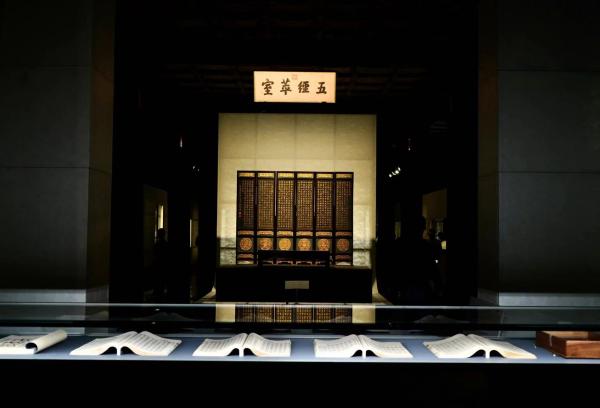
Emperor Qianlong's inscription "Five Classics Extraction Room" plaque and "Five Classics Extraction Room" screen map
No matter the royal inner court, noble officials, or ordinary scribes, they all like to display antiquities in the study, cultivate their sentiments, and amuse themselves.
In "Hongli is One and Two Chart Axis", Emperor Qianlong is dressed in Han costume and is enjoying various antiquities placed around the couch, including bronze ware (gou, plate, jue, scorpion, etc.), jade ware (bi, bucket, etc.) ), porcelain (bottles, bowls, jars, etc.), paintings and calligraphy, rare and ancient books, which can be seen in the collection of the Qing Dynasty. 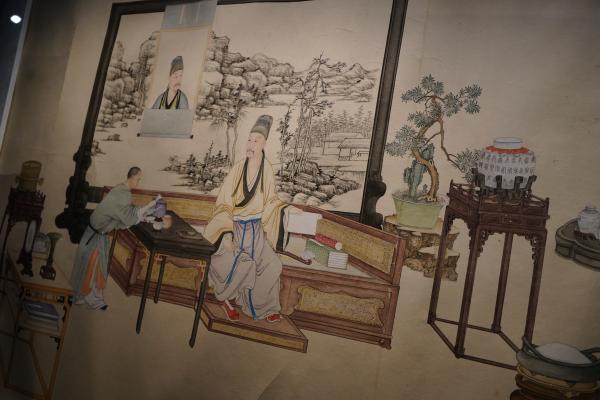
Hongli is one axis
The precious literary play in "Hongli is one and two picture axes" also "walked" from the painting to the exhibition hall. 
Northern Song Dynasty Jun Kiln Rose Purple Glazed Sunflower Flower Pot
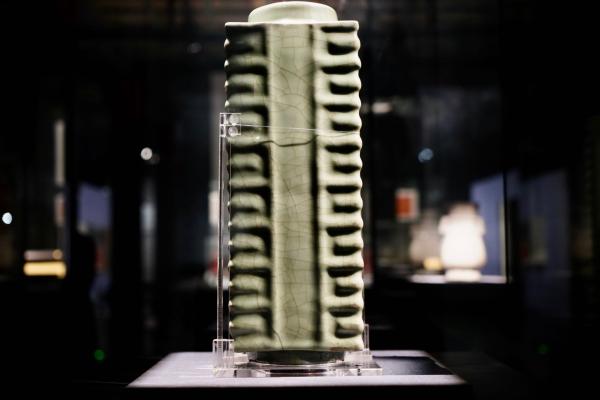
Southern Song Dynasty Longquan celadon-glazed cong-shaped vase
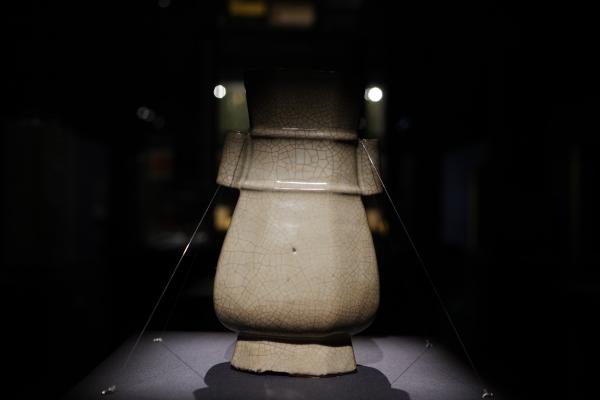
Southern Song Dynasty Ge Kiln Grey and Green Glazed Pot
The four treasures of the study are gathered here
The pen, ink, paper and inkstone are known as the four treasures of the study, and are a must-have item in the study. The literati and doctors use this special writing tool to create a pen and flower with ink, and send it into writing.
Among the cultural relics on display, the red sandalwood travel stationery box is a set of combined stationery in the form of a box, made in the 21st year of Qianlong (1756). People press the mechanism and turn the wooden box over, and the stationery box will be transformed into a movable desk. There are boxes, drawers and other storage boxes in the suitcase. The box is full of layers, grids, slots, etc., and the design is clever. It is used for placing all kinds of stationery utensils. 
red sandalwood travel stationery
Lacquer boxes are containers for stationery, food, and sundries. A lacquer box in the cultural relic, the theme of the box is four peony flowers, with stretched and curled branches and leaves. Whether it is pedicel, calyx or petals, flowers and leaves, they are all vivid and natural. The bottom of the box is painted with black lacquer and has the "Da Ming Xuande Year System" style. 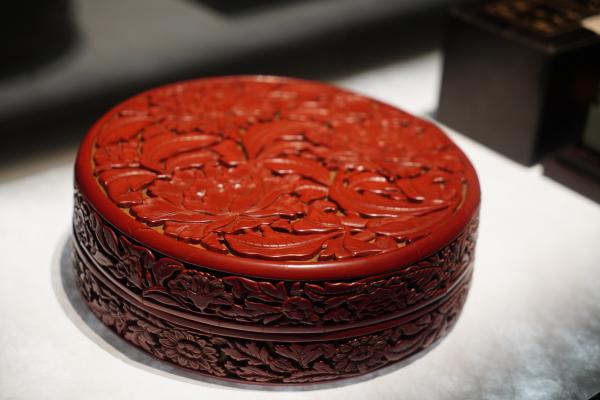
Peony Lacquer Box
A Qingtian stone seal of "Music Books to Eliminate Worry", the seal stone is of Qingtian stone quality. On the square printed surface, Zhu Wen said "Music Books to Eliminate Worry", and the side of the seal is engraved with "Wang Sun Puppets were made in the Xiuzhu Mountain Room. Musical Books to Eliminate Worries. Wen Peng". "Music Books to Eliminate Worry" comes from Tao Yuanming's "Returning and Coming Back". Tao Yuanming was reluctant to bow down for five buckets of rice, longing to return to the pastoral garden, and hoped to return to his study to entertain himself by playing the piano and reading. 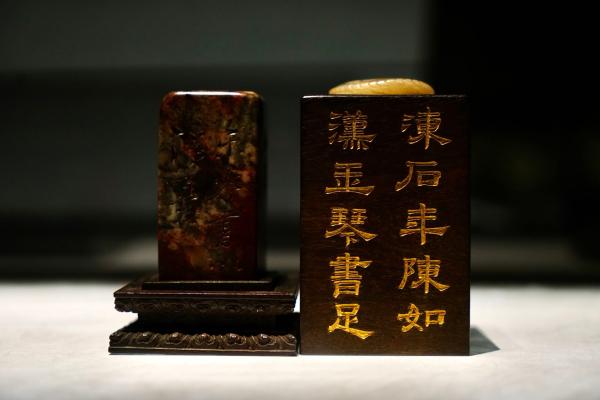
"Music Books to Eliminate Worries" Qingtian Shizhang
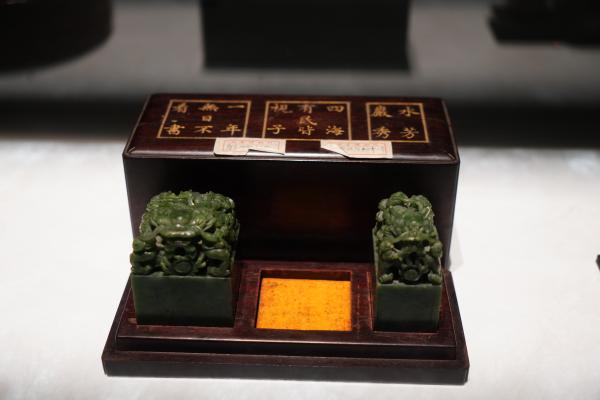
"A year without reading a book" and other prints
A pen case is a stationery tool used by literati to store new pens for use. A pen case in the exhibition is engraved with red lacquer and decorated with the pattern of clouds, mountains and waterfronts. The box contains 50 new pens. The material, decoration and shape of each pen are different. The pen barrel is also inscribed with poems about flowers written by Emperor Qianlong in different periods, reflecting his love for flowers and his outlook on life. 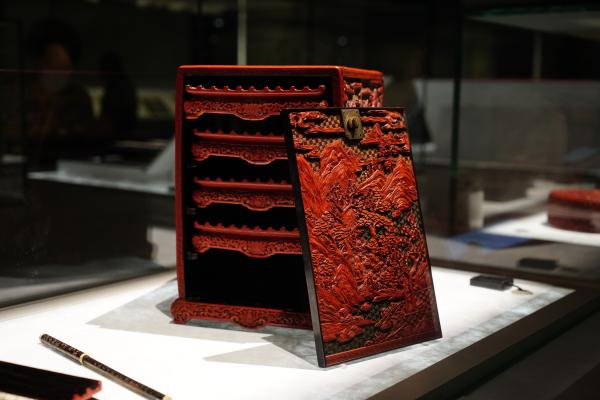
red lacquer pen case
The image of pine, plum and bamboo as the sustenance of the literati spirit
The study has life, and in the communication between man and heaven and earth, the aura of grandeur fills it. With the help of the characteristics of natural objects to convey the quality of people themselves, pine, bamboo and plums have become the image of the study and the spiritual sustenance of the literati. Confucius said, "Benefits are three friends, friends are straight, friends are understanding, and friends are more knowledgeable." In Song Dynasty, Su Shi's "Wuchang Hanxi Xishan Temple" called "two music of wind and spring, and three friends of pine and bamboo". Since then, the study has been accompanied by three friends, Song Yuzhi , Mei Yuliang, and Zhu Yuliang have become symbols of the temperament and spirit of scholars.
In the exhibition, the fragrant snow space of the Forbidden City, which is swaying with bamboo shadows, is first reproduced with multimedia and installations. 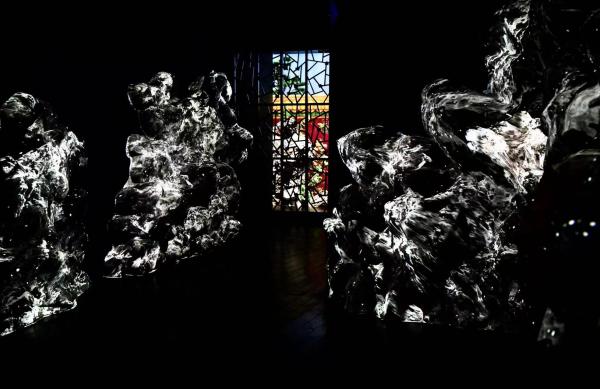
exhibition site
When creating a natural environment, all kinds of mountains and rocks are indispensable. A piece of Yunshi Lingbi stone made from Huifeng Pavilion in the Yuan Dynasty, because the stone is "like the tendency of the sky to restrain the clouds and hold the cliffs and cloths", it is taken from Li Daoyuan's "Water Classic Notes". ", named after the sentence "Making a cloud and standing on a wall", and the word "Making a cloud" is engraved on the stone forehead. There are eight inscriptions on the stone, five inscriptions by Yuan people and three inscriptions by Ming people. It was originally displayed in the northwest corner of Huifeng Pavilion behind Fuchen Hall in the Forbidden City. 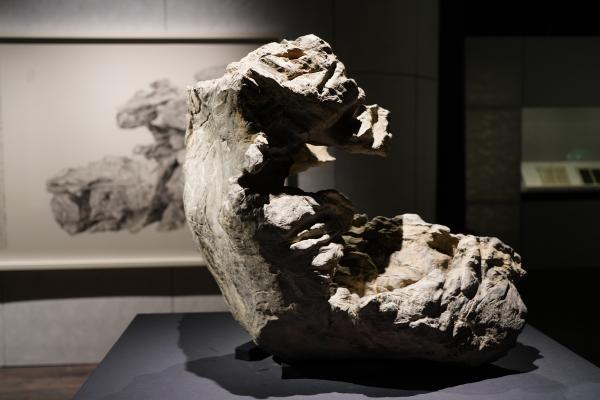
Yuanhui Fengting made marble Lingbi stone
The screen is made in Qianlong year. The side seat is made of red sandalwood, and the center of the screen is inlaid with glass. The double red sandalwood is carved with pine, bamboo and plum stems and glass, and the jade leaves and flowers are inlaid on it, forming a window-style borrowed scene of pine, bamboo and plum. Sumeru seat is inlaid with bamboo and orchid patterns. 
Qianlong year system interstitial

Underglaze three-color pine, bamboo and plum drawing pen holder
A literati space where the water flows and sings and gathers together
Literati with like-minded interests and like-minded people walked out of the study, sang waters, sang elegant collections, wandered eyes, looked up to heaven and earth, and experienced the finiteness of life and the infinity of the universe in mutual exchanges.
Ancient literati and doctors often had a tradition of meeting each other. They often shared their feelings in the study, garden, and mountain forest, looked up to the universe, and expressed their understanding of life through communication. Such like-minded gatherings are called "elegant gatherings". There are many famous literati gatherings in history, such as Lanting Gathering and Jinguyuan Gathering in Qushuiliujing in Wei and Jin Dynasties, Eighteen Bachelor Gatherings in Tang Dynasty, Jiulao Gathering in Xiangshan, Luoyang Qiying Association in Song Dynasty, Yuan Dynasty Gathering Gathering The elegant collection of Yushan in Dai Yushan and the elegant collection of Xingyuan in the Ming Dynasty have all become stories of literary gardens and art forests sung and depicted at that time and later generations. 
The exhibition hall space presents a beautiful booth layout
On the Qushuiliujing booth, a white-glazed rabbit jar is a cultural relic of the Tang Dynasty. Tang Dynasty literati described the various advantages of high-quality white porcelain. Lu Yu commented that its color and texture were "similar to silver" and "similar to snow". rise". From the Song and Yuan Dynasties to the Ming Dynasty, Jingdezhen kiln sweet white glaze, Dehua kiln white porcelain, the glaze color is pure and bright, and the enamel piles like cream. 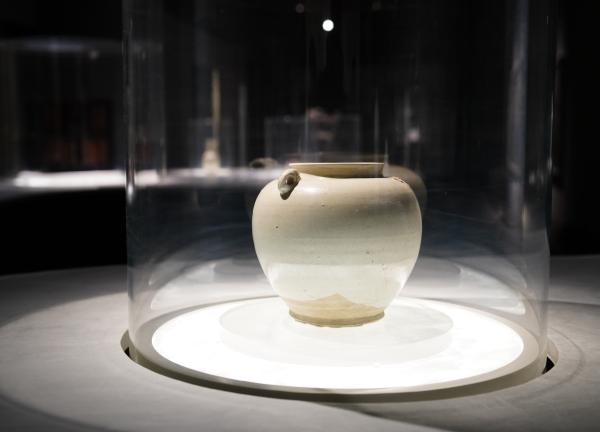
Tang Bai Glazed Rabbit Jar
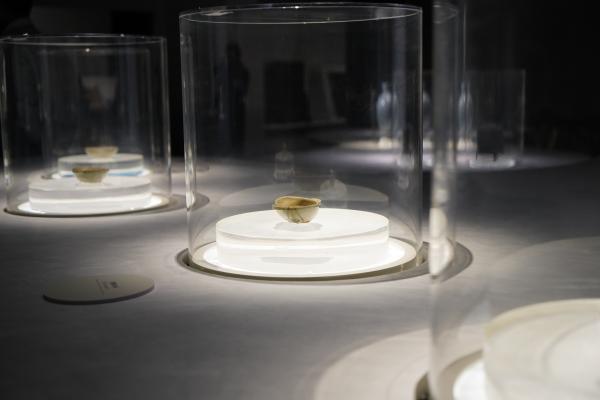
Various ear cups
In the painting and calligraphy exhibition, Yang Weizhen's running book "Xiao Xiao Ao Dong Xuan Poems Album" is a record of Yang Weizhen's invitation to Xiao Ao Dong Xuan's banquet, and he composed a piece of seven rules. The brush strokes are strong and unrestrained, and the ink is dripping, which shows the characteristics of his calligraphy. 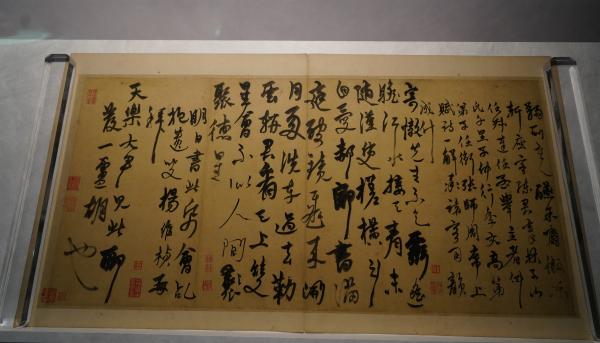
Yang Weizhen, "Xiao Xiao Ao Dongxuan's Poetry Album"
Shen Shi's "Lanting Renovation and Renovation" was written in the eighth year of Chongzhen (1635), showing the famous literati collection of "Lanting Renovation". 
Shen Shi's "Lanting Renovation Scroll"
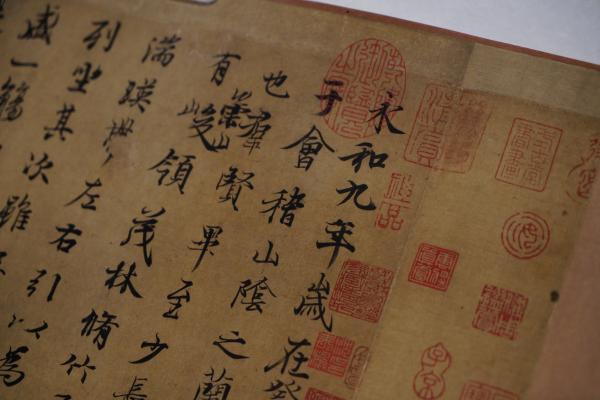
Dong Qichang Linliu Gongquan Lanting Scroll
The exhibition lasts until October 23, and the exhibition is free to visit with tickets to the Forbidden City, but reservations are required. According to the needs of epidemic prevention and control, according to the principle of limited quantity, appointment, and staggered peak, 3,000 people per day, until the appointment is full.